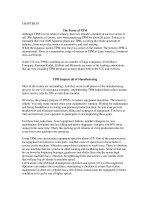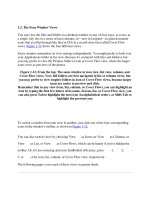Tài liệu The Marketing Leadership Audit pdf
Bạn đang xem bản rút gọn của tài liệu. Xem và tải ngay bản đầy đủ của tài liệu tại đây (112.65 KB, 11 trang )
Fulbright Economics Teaching Program
2004-2005
Marketing Places
Readings
The Marketing Leadership Audit
The Marketing Leadership Audit
Introduction
The Marketing Leadership Audit has educational and team building components. One
objective of this session is to assess your place or company’s market orientation. You will see
that there are several underlying factors to market orientation and that the extent to which a
manager of a company/place is market-oriented –and a leader—is somewhat contingent upon
perception. A second objective therefore is to give you the opportunity to discuss openly with
your differences in perceptions about your market orientation and to consider areas in which
your team can be strengthened and thus become or continue to be a market leader.
Instructions
1. Carefully complete the Marketing Leadership Audit. Take your time; reflect upon each
item before checking a numerical response. You may want to place notes in the margins so
that when you discuss the item with your colleagues, relevant issues can be considered in
greater detail.
2. Self-select groups of four persons (one group may be slightly larger or smaller depending
upon the number of participants in the seminar.) Select colleagues who have similar job
descriptions, who work with you on projects, are from the same business unit, or select a
group based on some other criterion that suggests to you that the group is comprised of
individuals with similar work roles. Once the group is formed assign different team
members the following roles:
• Moderator: Crystallizes ideas, keeps discussion focused, monitors time.
• Tabulator: Computes mean scores of individual items, sub factors and total audit.
• Scribe: Prepares overheads of team’s presentation.
• Spokesperson: Presents the team’s findings; observations and recommendations.
3. Discuss each item and compare different ratings. If ratings for an item vary within the
team, discuss why? Come to a consensus rating, but note dissenting opinions and minority
views. The tabulator should record the mean of the scores as well as the consensus score for
each item. Remember: the tabulator also records mean scores for each of the factors and
the total audit, but these scores should be calculated using the consensus measures.
4. The scribe should crystallize the discussion and make notes of highlights and salient issues
emerging from discussion. Experience shows that team discussion is more efficient and
meaningful when the scribe’s notes are available for regernce by the other team members.
5. Summarize your team’s conclusions and prepare your transparencies.
• List the factors and mean scores for each factor.
1
Fulbright Economics Teaching Program
2004-2005
Marketing Places
Readings
The Marketing Leadership Audit
• Record the mean score for the entire audit.
6. Help the spokesperson prepare a synopsis of your discussion.
• The spokesperson should:
Present general conclusions.
Report issues that led to considerable discussion and dissenting opinions.
Assess the organization’s/place’s orientation toward marketing leadership.
2
Fulbright Economics Teaching Program
2004-2005
Marketing Places
Readings
The Marketing Leadership Audit
Marketing Leadership Audit
Values
To what extent is a concern for customers reflected in the attitudes, beliefs and management
practices of your organization? To answer this question, check the appropriate box opposite
each of the following items:
1. In our organization, we view marketing as an investment rather than
an expense
2. For us serving the customer is a central organizational value; one that
informs everyone’s notions
3. We try hard not only to meet but to exceed customers’ expectations
4. We strive for top quality in our products and services and take great
pains to communicate this to our employees and stakeholders
5. Senior management in our organization reads, listens to, and responds
to customer complaints on a regular basis
6. We view product defects and poor service as the our problem – not the
customer’s problem
7. In our organization, we play down the product and play up our
commitment to customers
8. Our concern for customers is evident in little things – for example, we
reserve our best parking places, seats, etc. for our customers
9. We believe that the quality of our products and services is the best
means of communicating our image as a company or place
10. We try to focus people’s emotional energies outward …on winning in
the marketplace … rather than inward … on job security
3
To no extent
To a little extent
To some extent
To a great extent
To a very great extent
11. We set prices based on their perceived value.
12. Our strategies flow from an analysis of customer needs and our
competitor’s capabilities and strategies – not this year’s budget or last
years performance
13. We consider the “soft” impressionistic information we get from
talking to customers just as important as the data we get formal
surveys.
14. We view complacency as an ever-present threat and do everything we
can to avoid it
15. Responsiveness to customers is a regular subject of discussion within
our company
16. People in our organization have the sense that what they do matters –
they know the value they add to customers
17. We use “frequent flyer” – like incentives, among other things, to
reward customers for their loyalty
18. We involve customers early and directly in our product or place
development process
19. People in our organization feel like they “own” it and take
responsibility for its success
20. All of our employees know the good and bad of our performance as a
company or place
21. Product quality for us is an absolute requirement
22. Listening – and responding to customers – is a way of living in our
organization
23. We worry about fairness in our organization ... to customers, suppliers,
employees, etc.
Assign the following points to answers in each column
To no extent
To a little extent
To some extent
To a great extent
To a very great extent
1 2 3 4 5
Marketing Leadership Audit
Integration
To what extent is marketing integrated with other functions of the business? To indicate your
answer, check the appropriate box opposite each of the following items:
1. We have systems and procedures which promote a high degree of
control and coordination between marketing and the other functions of
the organization
2. Marketing, sales, and customer service are integrated at the top to
promote cooperation and coordination
3. Marketing and the other functions work well together – there is a high
degree of communication and collaboration
4. We work to create a sense of personal familiarity and mutual
obligation among employees
5. We have a variety of tools for getting people to talk across functions –
and we use them
6. We have a well organized product or place development process
7. We involve customers early and directly in our development process
8. Every department in our organization knows who its customers are,
internal and external
Assign the following points to answers in each column
To no extent
To a little extent
To some extent
To a great extent
To a very great extent
1 2 3 4 5









